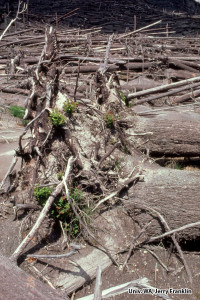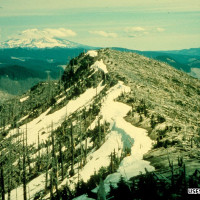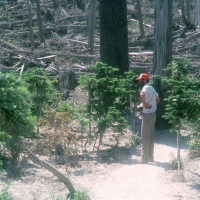Why did so many plants and animals survive the eruption?
The early spring timing of the eruption meant that there were still late-lying snow banks on high mountain ridges that sheltered some forest plants from the full effects of the blast. Timing was also important to the survival of non-woody plants because the eruption hit the plants at a time when they were least vulnerable to scouring and burial by the blast. Late May is a time when plants on high mountain ridges were still dormant and many roots survived beneath the ash deposits.
- North-facing slopes that were snow-covered and facing away from the volcano were protected from the blast (blast direction is right to left). Note standing dead trees that were snapped off at ridge height and small trees that were protected under thick snow banks.
- Snow-protected Pacific silver fir and mountain hemlock trees have served as important seed sources for forest re-establishment inside the blast zone.
The most conspicuous plant survivors were patches of Pacific silver fir (Abies amabilis) and mountain hemlock (Tsuga mertensiana) trees that survived the eruption intact, bent over beneath deep snow banks. Other woody shrubs like huckleberry (Vaccinium spp.) and salmonberry (Rubus spectabilis) survived on snow-covered north-facing slopes or in isolated pockets behind steep ridges that deflected the blast.
Other chance circumstances contributed to plant survival throughout the 230 square mile blast zone. Scattered plants managed to survive on blocks of soil that clung to the root masses of blown down trees.

Huckleberries and other understory plants sprouted from soil on the root masses of blown down trees.
Other plants survived in sheltered pockets beneath fallen logs. These lucky survivors included forest plants such as bunchberry dogwood (Cornus canadensis), queen’s cup beadlily (Clintonia uniflora) as well as common shrubs such as huckleberry (Vaccinium spp.) and elderberry (Sambucus spp.).
The most common means of survival was from rootstocks that sprouted from the surface of the pre-eruption soil where ash deposits were thin (less than six inches, 15 cm) or where the pre-eruption surface had been exposed in the bottom of erosion gullies. The most common survivors were weedy plant species such as fireweed (Epilobium angustifolium) and pearly everlasting (Anaphalis margaritacea) that sprouted from the original soil surface in areas that had been clearcut prior to the eruption.




